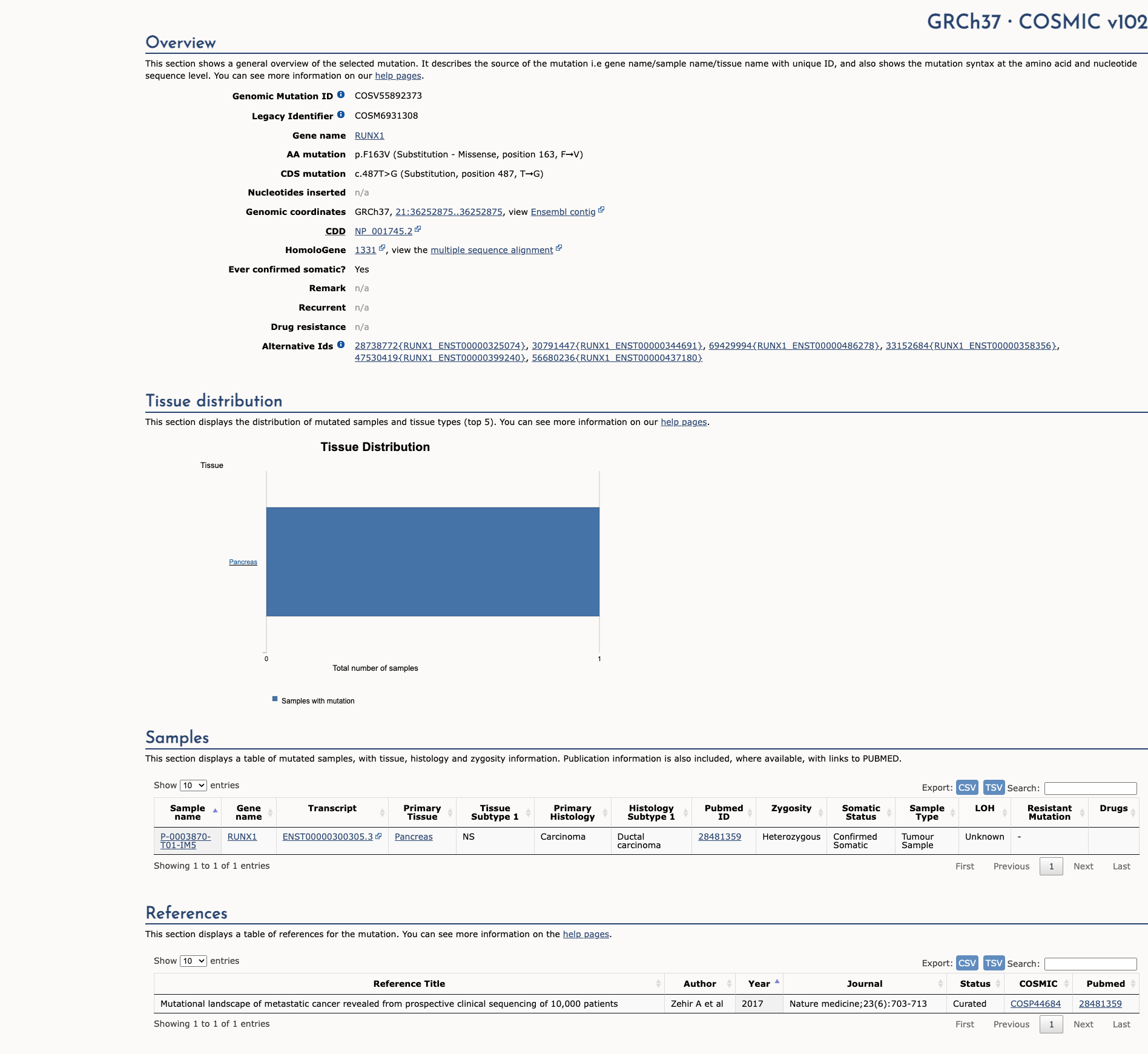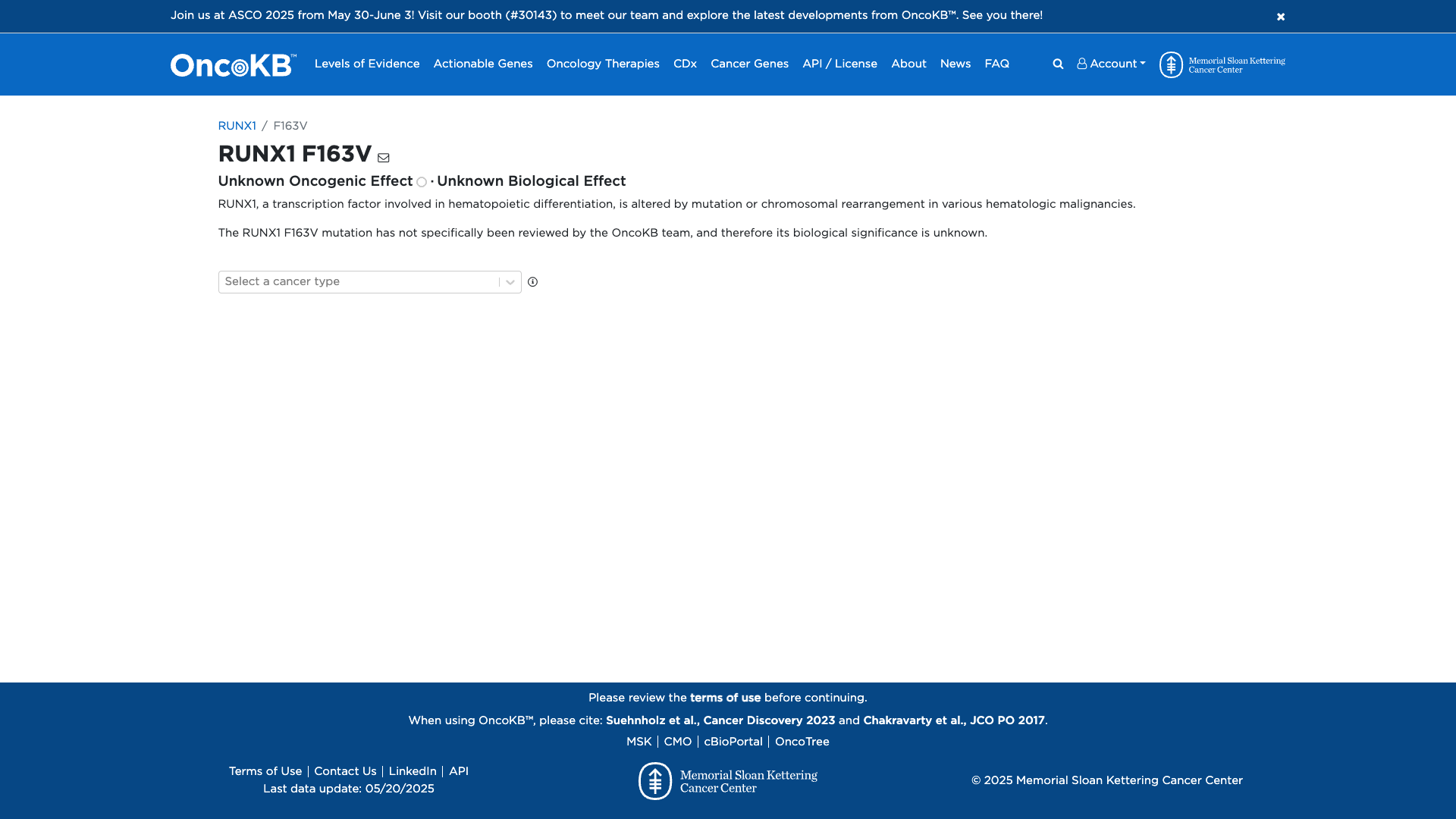RUNX1 c.487T>G, p.Phe163Val
NM_001754.4:c.487T>G
COSMIC ID: COSM6931310
Variant of Uncertain Significance (VUS)
Three supporting criteria (PM1, PM2, PP3) are met, with no moderate or strong pathogenic criteria, and no benign criteria. The evidence is therefore insufficient to move beyond a Variant of Uncertain Significance under ACMG/VCEP rules.
ACMG/AMP Criteria Applied
PM1
PM2
PP3
Genetic Information
Gene & Transcript Details
Gene
RUNX1
Transcript
NM_001754.5
MANE Select
Total Exons
9
Strand
Reverse (−)
Reference Sequence
NC_000021.8
Alternative Transcripts
| ID | Status | Details |
|---|---|---|
| NM_001754.3 | Alternative | 8 exons | Reverse |
| NM_001754.4 | RefSeq Select | 9 exons | Reverse |
Variant Details
HGVS Notation
NM_001754.4:c.487T>G
Protein Change
F163V
Location
Exon 5
(Exon 5 of 9)
5'Exon Structure (9 total)3'
Functional Consequence
Loss of Function
Related Variants
No evidence of other pathogenic variants at position 163 in gene RUNX1
Alternate Identifiers
COSM6931310
Variant interpretation based on transcript NM_001754.5
Genome Browser
Loading genome browser...
HGVS InputNM_001754:c.487T>G
Active Tracks
ConservationRefSeqClinVargnomAD
Navigation tips: Use mouse to drag and zoom. Click on features for details.
Clinical Data
Population Frequency
Global Frequency
0.0 in 100,000
Extremely Rare
Global: 0.0%
0%
0.05%
0.1%
1%
5%
10%+
ACMG Criteria Applied
PM2
This variant is not present in gnomAD (PM2 criteria applies).
Classification
Unknown
Publications (0)
No publication details.
Clinical Statement
Functional Impact
Functional Domain
Hotspot Status
Not a hotspot
Domain Summary
This variant is not located in a mutational hotspot or critical domain (0 mutations).
Related Variants in This Domain
No evidence of other pathogenic variants at position 163 in gene RUNX1
Computational Analysis
Pathogenicity Predictions
REVEL Score
0.986
0.986
Likely Benign0.0
Uncertain (Low)0.2
Uncertain (Med)0.5
Likely Pathogenic0.75
REVEL scores ≥ 0.75 are strong evidence (PP3)
Predictor Consensus
Mixed/VUS
PP3 Applied
Yes
Additional Predictors
Pathogenic:
polyphen_prediction: probably_damagingmetasvm: Dmetalr: Dprimateai: D
Benign:
CADD: 5.50
Neutral: Show all
VCEP Guidelines
Applied ACMG/AMP Criteria (VCEP Specific) VCEP Guidelines
PVS1
PVS1 (Not Applied) Strength Modified
According to VCEP guidelines, the rule for PVS1 is: "**Very Strong Strength**: Very Strong Per modified RUNX1 PVS1 decision tree for SNVs and CNVs and table of splicing effects. Modification Type: Gene-specific". The evidence for this variant shows: It is a missense variant (c.487T>G; F163V), not a null variant. Therefore, this criterion is not applied at Not Applied strength because PVS1 applies only to null variants.
PS1
PS1 (Not Applied) Strength Modified
According to VCEP guidelines, the rule for PS1 is: "**Strong Strength**: Strong Same amino acid change as a previously established pathogenic variant regardless of nucleotide change. Modification Type: None". The evidence for this variant shows: No previously established pathogenic variant results in F163V. Therefore, this criterion is not applied at Not Applied strength because there is no match to a known pathogenic amino acid change.
PS2
PS2 (Not Applied) Strength Modified
According to VCEP guidelines, the rule for PS2 is: "**Moderate Strength**: Moderate Phenotypic specificity category: 'Phenotype consistent with gene but not highly specific and high genetic heterogeneity' for de novo cases; **Supporting Strength**: Supporting for assumed de novo. Modification Type: Disease-specific,Strength". The evidence for this variant shows: De novo status is unknown. Therefore, this criterion is not applied at Not Applied strength due to lack of de novo confirmation.
PS3
PS3 (Not Applied) Strength Modified
According to VCEP guidelines, the rule for PS3 is: "**Strong Strength**: Strong Transactivation assays demonstrating altered transactivation (<20% of wt) AND data from a secondary assay demonstrating altered function; **Moderate Strength**: Moderate transactivation assays OR ≥2 secondary assays; **Supporting Strength**: Supporting transactivation assays demonstrating enhanced transactivation (>115% of wt). Modification Type: Gene-specific". The evidence for this variant shows: No functional studies have been performed. Therefore, this criterion is not applied at Not Applied strength because there are no functional assay data.
PS4
PS4 (Not Applied) Strength Modified
According to VCEP guidelines, the rule for PS4 is: "**Strong Strength**: Strong ≥4 probands meeting phenotypic criteria; **Moderate Strength**: 2–3 probands; **Supporting Strength**: 1 proband. Modification Type: Disease-specific". The evidence for this variant shows: No case reports or proband data. Therefore, this criterion is not applied at Not Applied strength due to absence of proband evidence.
PM1
PM1 (Supporting) Strength Modified
According to VCEP guidelines, the rule for PM1 is: "**Supporting Strength**: Supporting Variant affecting one of the other amino acid residues 89-204 within the RHD. Modification Type: Gene-specific,Strength". The evidence for this variant shows: F163V affects residue 163, which lies within the RHD domain (aa 89–204) but is not one of the specified key residues. Therefore, this criterion is applied at Supporting strength because the variant lies in a functionally important domain of RUNX1.
PM2
PM2 (Supporting) Strength Modified
According to VCEP guidelines, the rule for PM2 is: "**Supporting Strength**: Supporting Variant must be completely absent from all population databases. Modification Type: Strength". The evidence for this variant shows: Absent from gnomAD, 1000 Genomes, and other population databases. Therefore, this criterion is applied at Supporting strength because the variant is absent from controls.
PM3
PM3 (Not Applied) Strength Modified
According to standard ACMG guidelines, the rule for PM3 is: "Detected in trans with a pathogenic variant for a fully penetrant recessive disorder." The evidence for this variant shows: RUNX1-related disease is autosomal dominant and there is no evidence of a recessive, in-trans pathogenic variant. Therefore, this criterion is not applied at Not Applied strength because PM3 is not relevant for dominant disorders.
PM4
PM4 (Not Applied) Strength Modified
According to standard ACMG guidelines, the rule for PM4 is: "Protein length changes due to in-frame deletions/insertions in a non-repeat region or stop-loss variants." The evidence for this variant shows: It is a missense substitution without change in protein length. Therefore, this criterion is not applied at Not Applied strength.
PM5
PM5 (Not Applied) Strength Modified
According to VCEP guidelines, the rule for PM5 is: "**Strong Strength**: Strong Missense change at an AA residue where ≥2 different missense changes have been determined to be pathogenic; **Moderate Strength**: Moderate Missense change at a residue where a different missense change is pathogenic; **Supporting Strength**: Supporting Missense change at a residue where a different missense change is likely pathogenic. Modification Type: Strength". The evidence for this variant shows: No other pathogenic or likely pathogenic missense changes reported at F163. Therefore, this criterion is not applied at Not Applied strength.
PM6
PM6 (Not Applied) Strength Modified
According to VCEP guidelines, the rule for PM6 is: "**Moderate Strength**: Moderate de novo (proven or assumed) scoring; **Supporting Strength**: Supporting scoring. Modification Type: Disease-specific,Strength". The evidence for this variant shows: De novo status is unknown. Therefore, this criterion is not applied at Not Applied strength due to lack of de novo information.
PP1
PP1 (Not Applied) Strength Modified
According to VCEP guidelines, the rule for PP1 is: "**Supporting Strength**: Supporting co-segregation in 3–4 meioses; **Moderate/Strong** for more meioses. Modification Type: Disease-specific,Strength". The evidence for this variant shows: No family segregation data. Therefore, this criterion is not applied at Not Applied strength due to absence of segregation evidence.
PP2
PP2 (Not Applied) Strength Modified
According to standard ACMG guidelines, the rule for PP2 is: "Missense variant in a gene with low rate of benign missense variation and where missense variants are a common mechanism of disease." The evidence for this variant shows: Insufficient data on benign missense rate in RUNX1. Therefore, this criterion is not applied at Not Applied strength due to lack of constraint information.
PP3
PP3 (Supporting)
According to VCEP guidelines, the rule for PP3 is: "**Supporting Strength**: Supporting For missense variants: REVEL score ≥ 0.88. Modification Type: Gene-specific,Disease-specific". The evidence for this variant shows: REVEL score of 0.99, well above the 0.88 threshold. Therefore, this criterion is applied at Supporting strength because multiple computational tools predict deleterious effect.
PP4
PP4 (Not Applied) Strength Modified
According to standard ACMG guidelines, the rule for PP4 is: "Patient’s phenotype or family history highly specific for disease with a single genetic etiology." The evidence for this variant shows: No clinical phenotype data provided. Therefore, this criterion is not applied at Not Applied strength due to missing phenotype information.
PP5
PP5 (Not Applied) Strength Modified
According to standard ACMG guidelines, the rule for PP5 is: "Reputable source reports the variant as pathogenic without critical evidence." The evidence for this variant shows: Not present in ClinVar or other reputable sources. Therefore, this criterion is not applied at Not Applied strength.
BA1
BA1 (Not Applied) Strength Modified
According to VCEP guidelines, the rule for BA1 is: "**Stand Alone Strength**: Stand Alone Minor allele frequency between 0.0015 and higher. Modification Type: Disease-specific". The evidence for this variant shows: Allele frequency 0%. Therefore, this criterion is not applied at Not Applied strength.
BS1
BS1 (Not Applied) Strength Modified
According to VCEP guidelines, the rule for BS1 is: "**Strong Strength**: Strong Minor allele frequency between 0.00015 and 0.0015. Modification Type: Disease-specific". The evidence for this variant shows: Allele frequency 0%. Therefore, this criterion is not applied at Not Applied strength.
BS2
BS2 (Not Applied) Strength Modified
According to standard ACMG guidelines, the rule for BS2 is: "Observed in a healthy adult individual for a dominant disorder with full penetrance expected at an early age." The evidence for this variant shows: No data from healthy carriers. Therefore, this criterion is not applied at Not Applied strength.
BS3
BS3 (Not Applied) Strength Modified
According to VCEP guidelines, the rule for BS3 is: "**Strong Strength**: Strong transactivation assays demonstrating normal function AND secondary assay normal; **Supporting Strength**: Supporting transactivation assays demonstrating normal function. Modification Type: Gene-specific". The evidence for this variant shows: No functional assay data. Therefore, this criterion is not applied at Not Applied strength.
BS4
BS4 (Not Applied) Strength Modified
According to standard ACMG guidelines, the rule for BS4 is: "Lack of segregation in affected members of a family." The evidence for this variant shows: No segregation data. Therefore, this criterion is not applied at Not Applied strength.
BP1
BP1 (Not Applied) Strength Modified
According to standard ACMG guidelines, the rule for BP1 is: "Missense variant in a gene for which primarily truncating variants are known to cause disease." The evidence for this variant shows: RUNX1 has known pathogenic missense variants. Therefore, this criterion is not applied at Not Applied strength.
BP2
BP2 (Not Applied) Strength Modified
According to standard ACMG guidelines, the rule for BP2 is: "Observed in trans with a pathogenic variant for a fully penetrant dominant gene/disorder." The evidence for this variant shows: No evidence of trans with a pathogenic variant. Therefore, this criterion is not applied at Not Applied strength.
BP3
BP3 (Not Applied) Strength Modified
According to standard ACMG guidelines, the rule for BP3 is: "In-frame indels in repetitive regions without functional impact." The evidence for this variant shows: It is a missense change, not an in-frame indel. Therefore, this criterion is not applied at Not Applied strength.
BP4
BP4 (Not Applied) Strength Modified
According to VCEP guidelines, the rule for BP4 is: "**Supporting Strength**: Supporting For missense variants: REVEL score <0.50 AND SpliceAI ≤0.20." The evidence for this variant shows: REVEL score is 0.99. Therefore, this criterion is not applied at Not Applied strength.
BP5
BP5 (Not Applied) Strength Modified
According to standard ACMG guidelines, the rule for BP5 is: "Variant found in an individual with an alternate molecular basis for disease." The evidence for this variant shows: No alternate molecular diagnosis. Therefore, this criterion is not applied at Not Applied strength.
BP6
BP6 (Not Applied) Strength Modified
According to standard ACMG guidelines, the rule for BP6 is: "Reputable source reports variant as benign without evidence." The evidence for this variant shows: Not present in reputable databases. Therefore, this criterion is not applied at Not Applied strength.
BP7
BP7 (Not Applied) Strength Modified
According to VCEP guidelines, the rule for BP7 is: "**Supporting Strength**: Supporting BP7 is applicable for synonymous and intronic variants with SpliceAI ≤0.20 AND conservation predictions ≤2.0. Modification Type: Gene-specific,Disease-specific". The evidence for this variant shows: It is a missense variant. Therefore, this criterion is not applied at Not Applied strength.



